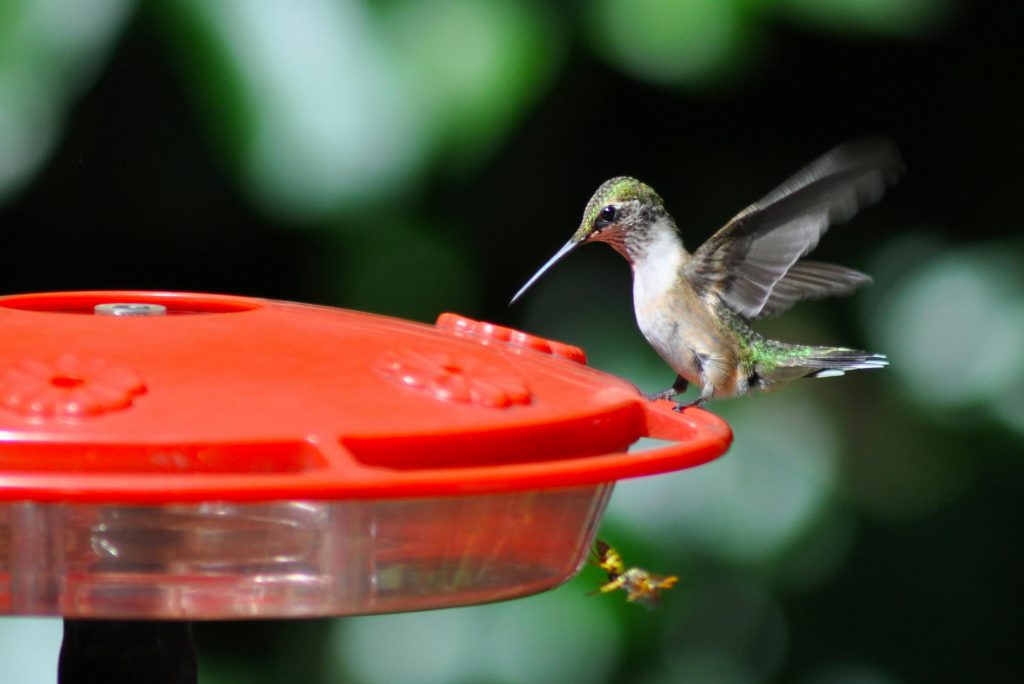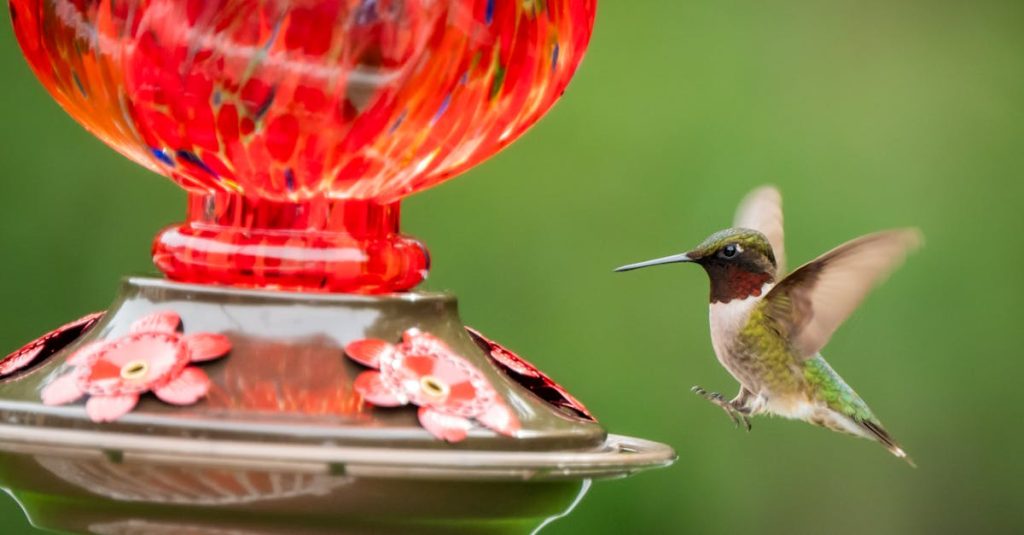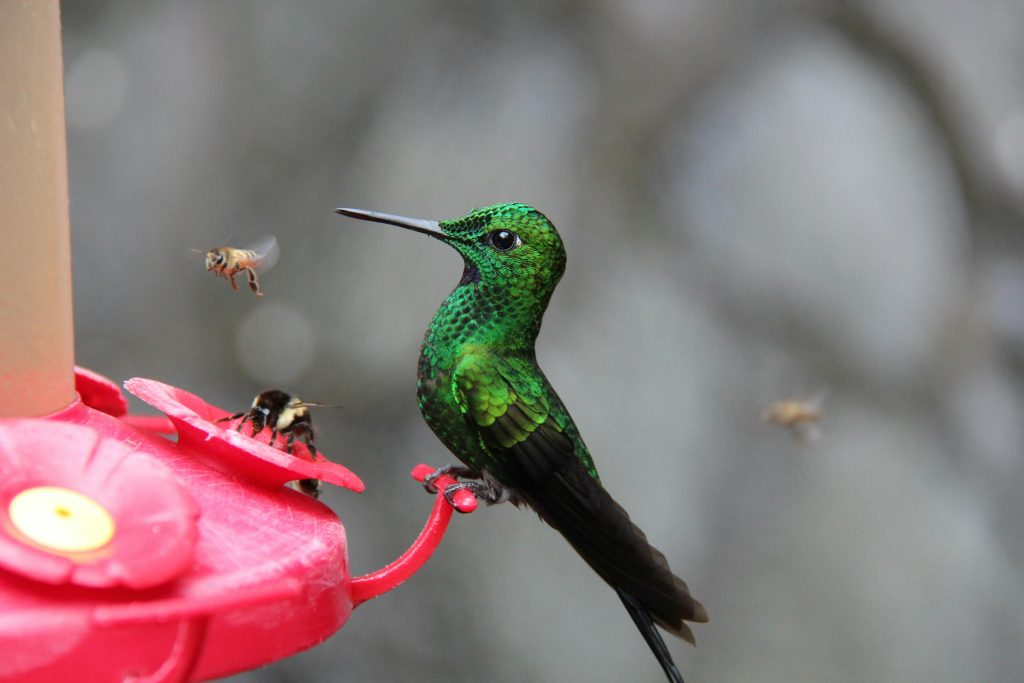Ants are a common nuisance for hummingbird enthusiasts and it is sometimes difficult to keep ants out of hummingbird feeders. They are drawn to the sweet nectar in feeders. This can deter hummingbirds from visiting your garden.
Keeping ants out of hummingbird feeders is crucial. It ensures a safe and inviting space for these tiny pollinators. Fortunately, there are effective strategies to tackle this issue.
Understanding why ants are attracted to feeders is the first step. This knowledge helps in implementing the right prevention methods. Ants are persistent, but so are we.
There are various ways to deter ants. From natural remedies to mechanical barriers, each method has its benefits. Combining several strategies often yields the best results.
Ant moats are a popular choice. They create a physical barrier that ants cannot cross. This simple solution is highly effective.
Natural deterrents like cinnamon and essential oils can also help. These substances repel ants without harming hummingbirds. They are safe and easy to use.
Regular maintenance and cleaning are essential. Keeping feeders clean reduces ant attraction. It also ensures a healthy environment for hummingbirds.
Creating a pollinator-friendly garden involves more than just feeders. Incorporating native plants can support biodiversity. This attracts hummingbirds and other beneficial wildlife.

Why Ants Are Attracted to Hummingbird Feeders
Ants are attracted to hummingbird feeders primarily because of the sugar content. The sweet nectar mimics natural floral nectar, drawing ants in. This sugar source is a valuable food for them.
The location and design of feeders also play a role. Easy access to feeders can increase ant visits. Feeder leaks exacerbate the problem by providing ants with an entry point.
Understanding these factors helps in implementing effective deterrents and keep ants out of hummingbird feeders. Key reasons for ant attraction include:
- Sweet sugar water
- Feeder leaks and spills
- Proximity to ant habitats
Knowing what draws ants can guide prevention strategies. Addressing these attractants is crucial for keeping your feeders ant-free.

The Impact of Ants on Hummingbirds and Feeders
Ants in your hummingbird feeders can cause several issues. Their presence can deter hummingbirds, disrupting their feeding routine. Hummingbirds may avoid feeders altogether if ants become a persistent problem.
Ants can contaminate the nectar, affecting its quality. They may introduce bacteria or other pathogens into the sugar water. This can pose health risks to the hummingbirds. This is why it’s essential to keep ants out of hummingbird feeders.
Ants can also cause mechanical damage to feeders. They might chew on plastic parts, leading to leaks or damage. Over time, this can reduce the feeder’s effectiveness and lifespan. Protecting your feeders from ants ensures a safe feeding environment for hummingbirds.

Essential Prevention Strategies: Quick Overview
Keeping ants away from your hummingbird feeders requires a strategic approach. By understanding effective barriers and deterrents, you can provide a safe feeding environment to keep ants out of hummingbird feeders.
Here are some quick strategies to deter ants:
- Use ant moats to create a physical barrier.
- Hang feeders with fishing line, as ants struggle to climb it.
- Apply natural deterrents like cinnamon or essential oils.
- Regularly clean feeders to remove sugar residue.
- Consider ant-proof feeders with built-in features.
Implementing these methods can significantly reduce ant activity around your feeders. Consistent maintenance and observation help ensure ongoing success in keeping ants at bay.
Ant Moats: The Most Effective Barrier to keep ants out of hummingbird feeders
Ant moats are one of the simplest and most effective ways to stop ants from invading hummingbird feeders. These water-filled cups serve as a barrier between ants and the sugary nectar they seek. Easy to install, they fit above your feeder on the hanger.
Ants are unable to swim, making moats an excellent obstacle for them. As long as the moat is maintained and filled with water, it remains a significant deterrent.
Most commercially available ant moats are designed to be durable and easy to use. However, making your own can be an inexpensive and satisfying project. The key is to ensure the moat is always filled with water.
To use an ant moat effectively, remember the following:
- Place the moat directly above the feeder.
- Check regularly and refill as needed.
- Ensure the water is clean and fresh.
Whether purchased or homemade, ant moats are an essential tool for any hummingbird enthusiast. They allow hummingbirds to feed undisturbed, keeping ants from becoming an overwhelming problem.

How to Build a DIY Ant Moat
Creating your own ant moat is a straightforward process that can be both practical and cost-effective. Start by gathering simple materials like a plastic cup, a wire, and a strong adhesive. This will give you the best chance to keep ants out of hummingbird feeders.
Drill a small hole in the bottom of the cup for the wire to pass through. Next, attach the wire securely to ensure the moat can hang above the feeder without wobbling. Use waterproof adhesive for added strength.
Fill the cup with water, and hang it between the feeder and its support. The water acts as a barrier, keeping ants at bay. Regularly check and refill the water to maintain its effectiveness in order to keep ants out of hummingbird feeders.
Here’s a simple checklist for your DIY ant moat:
- Gather materials: plastic cup, wire, adhesive.
- Drill a hole and attach the wire securely.
- Fill with water and hang above the feeder.
With your homemade moat, you provide an effective defense against ants. This simple project ensures your hummingbird feeder remains a haven for birds, free from invasive ants.


Using Fishing Line to keep ants out of hummingbird feeders
Fishing line can be a surprisingly effective tool in deterring ants from reaching hummingbird feeders. Its smooth surface makes it difficult for ants to climb, providing a simple yet smart solution. By hanging feeders with fishing line, you reduce the chances of ants finding their way to the nectar.
To implement this method, replace existing feeder cords with fishing line. Ensure it’s sturdy enough to support the feeder’s weight. This adjustment can make a significant difference in ant activity around your feeders.
Here are the steps to use fishing line for ant prevention:
- Choose a strong fishing line to support the feeder.
- Securely tie the feeder using the line.
- Regularly inspect for any damages or wear.
This approach not only deters ants but maintains a clean and attractive feeding station.

Natural Ant Deterrents: Cinnamon, Essential Oils, and More
Natural remedies can effectively keep ants at bay without harming the environment or hummingbirds. Cinnamon, for instance, acts as a potent ant deterrent due to its aromatic properties. Sprinkle cinnamon around the feeder base to disrupt ant trails.
Essential oils also serve as powerful ant repellents. Oils like peppermint and tea tree are particularly effective. Ants detest their strong scents, making them useful in creating a barrier around feeders and keep ants out of hummingbird feeders effectively.
To apply, mix a few drops of essential oil with water in a spray bottle. Lightly mist the feeder pole and nearby areas. This creates a fragrant shield that ants avoid and will keep ants out of hummingbird feeders.
Here’s a list of natural ant deterrents:
- Cinnamon powder
- Peppermint essential oil
- Tea tree essential oil
These solutions offer a safe method to protect feeders while supporting a healthy habitat for hummingbirds.

Petroleum Jelly, Vaseline, and Slippery Barriers: Do They Work?
Petroleum jelly and Vaseline can create an effective, slippery barrier to deter ants from climbing feeder poles. Ants struggle to navigate such slick surfaces, reducing their ability to reach the feeder.
Apply a thin, even layer of petroleum jelly around the pole or hanger. Be careful not to use too much, as it can become a sticky mess in hotter weather. Regularly check and reapply to maintain effectiveness.
Here is why slippery barriers work:
- They prevent ants from gaining traction.
- They form a physical barrier between ants and the feeder.
- They are safe and easy to apply without harming birds.
Incorporating slippery barriers is a practical step toward keeping feeders ant-free.

Ant Traps and Commercial Solutions
Ant traps can be a helpful addition to your ant prevention arsenal. They provide a targeted solution by luring ants away from the feeder. These traps are easy to use and widely available at garden centers.
Commercially available ant moats are another option. They are designed to hold water, creating a natural barrier. Some even have added features like hooks for convenient hanging.
When choosing these solutions, consider the following:
- Look for non-toxic options to protect hummingbirds.
- Select traps designed specifically for outdoor use.
- Regularly monitor and maintain these traps to ensure effectiveness.
Incorporating both traps and commercial solutions can provide comprehensive ant control.

Placement and Maintenance: Reducing Ants out of Hummingbird Feeders
Strategic placement of hummingbird feeders can significantly reduce ant invasion. Hanging feeders away from trees and structures limits ants’ pathways. This simple step can cut down on ant access dramatically.
Regular maintenance is crucial in keeping feeders ant-free. Ensuring feeders are clean reduces sugar residue, which attracts ants. Frequent inspections help identify and address infestations early.
To optimize your placement and maintenance routine, consider these tips:
- Place feeders in open areas, avoiding direct contact with surfaces.
- Regularly clean the feeder to remove any spills.
- Inspect hanging mechanisms for ant trails or damage.
A well-positioned and maintained feeder offers a welcoming space for hummingbirds, keeping ants out of hummingbird feeders.

Cleaning and Upkeep: Keeping Feeders Ant-Free
Routine cleaning is vital for preventing ants. Dirty feeders with sugar remnants become magnets for ants. Regularly cleaning the feeder disrupts ants’ pheromone trails will surely help keep ants out of hummingbird feeders.
Follow these simple steps for effective maintenance:
- Clean the feeder with hot water every few days.
- Use a soft brush to remove residues from ports.
- Rinse thoroughly to prevent sugar buildup.
Vigilance is also crucial. Consistent upkeep of feeders keeps them enticing for hummingbirds and unappealing to ants. Remember, a clean environment not only benefits your feathered visitors but also ensures sustained feeder functionality.

Home Remedies and DIY Ant Repellents
Home remedies can be effective in deterring ants. These natural solutions often come from ingredients you already have. They offer a chemical-free approach to pest control by putting ants out of hummingbird feeders and deterring them elsewhere.
Consider trying these DIY ant repellents around your feeder areas:
- Cinnamon: Sprinkle around the feeder base.
- Vinegar and water solution: Spray near feeding zones.
- Essential oils: Use peppermint or tea tree oil diluted in water.
It’s essential to reapply these solutions regularly for continued effectiveness. While these remedies may not eliminate ants, they help in reducing their numbers significantly. Keep experimenting to find what works best in your specific garden setting.

What to Avoid: Pesticides and Harmful Chemicals
Using pesticides around hummingbird feeders is not safe. They can harm the delicate birds you aim to attract. Hummingbirds are sensitive to many substances and you should NOT use harmful chemicals to keep ants out of hummingbird feeders.
Instead of chemical solutions, consider these alternatives:
- Avoid toxic sprays: Stick to natural deterrents.
- Do not coat feeders with oils that could harm birds.
- Refrain from using any form of synthetic pesticide.
By avoiding harmful chemicals, you protect not only hummingbirds but other essential garden wildlife. Always prioritize the safety of your pollinators over convenience.
Frequently Asked Questions About Ants and Hummingbird Feeders
Can ants climb fishing line? Yes, ants can climb most surfaces, but fishing line is quite slippery. It gives them a tough challenge.
Will cinnamon keep ants away from hummingbird feeders? Cinnamon is a natural deterrent. Sprinkling it around the feeder base can keep ants at bay. Your results might very, but worth a shot!
How effective are ant traps for hummingbird feeders? Ant traps are great for capturing ants before they reach the nectar. They offer protection.
What are some natural ant repellents? Essential oils, like peppermint and tea tree, are effective. They are easy to apply and eco-friendly.
Do I need to move my feeders often? Changing feeder locations can confuse ant trails. It helps reduce infestations effectively.
How can I prevent ants without chemicals?
Consider these non-chemical methods:
- Use ant moats as a physical barrier.
- Regularly clean to remove sugar residues.
- Select feeders with built-in ant features.
Creating a Pollinator-Friendly Urban Garden
Designing a garden that attracts hummingbirds and other pollinators involves selecting the right plants and layout. Native flora is crucial, as it supports local wildlife and minimizes pests.
Focus on plant diversity to provide a variety of nectar sources. This attracts a wider range of pollinators, enriching your garden ecosystem.
Consider these tips for a thriving pollinator garden:
- Plant groups of native flowers.
- Provide water sources for birds and insects.
- Avoid pesticides to protect pollinators.

Integrate these practices into your urban landscape to create a haven for hummingbirds and other vital pollinators. By doing so, you’ll support biodiversity and enhance your outdoor space.
Conclusion: Consistency and Observation Are Key
Successfully keeping ants out of hummingbird feeders requires diligence and observation. Regular maintenance and quick interventions can prevent ant infestations from taking hold.
Remember, no single solution fits all. Combining several methods often yields the best results. Observing which techniques work best for your garden can make all the difference.
Commit to trying different strategies as needed. Continued observation and adjustments will ensure your garden remains a hummingbird-friendly oasis. This effort supports vibrant, healthy biodiversity in your urban environment.


